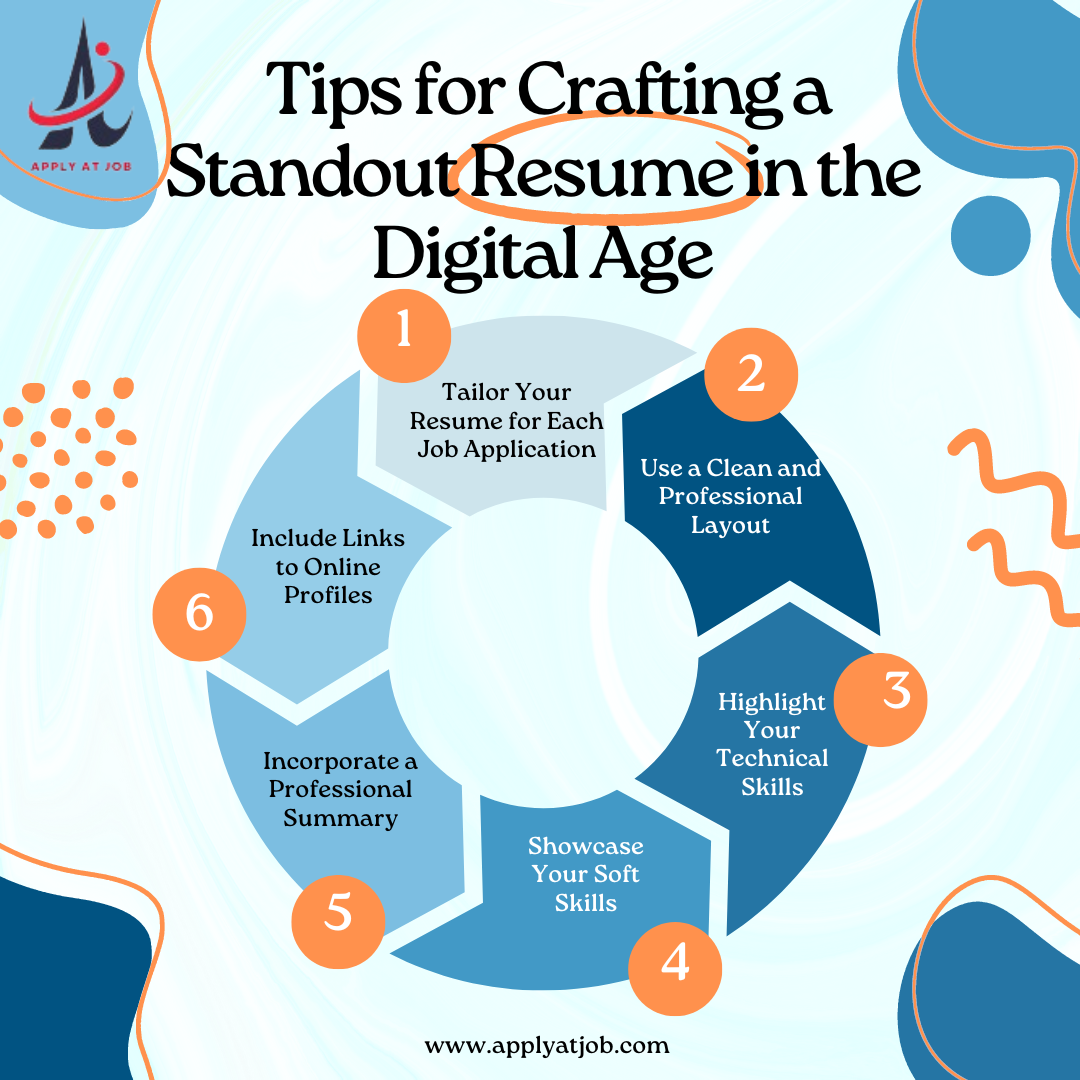
Creating a standout resume in today's digital landscape requires a blend of traditional best practices and modern techniques. Here are some detailed tips to help you craft a resume that catches the eye of recruiters and hiring managers:
1. Tailor Your Resume for Each Job Application:
Customizing Content:
Relevant Experience: Highlight experiences and skills that match the job description.
Keywords: Incorporate keywords from the job posting to pass through Applicant Tracking Systems (ATS).
Specific Achievements:
Quantifiable Results: Include specific achievements with quantifiable results (e.g., "Increased sales by 20%").
Relevant Projects: Mention projects that are directly relevant to the job you're applying for.
2. Use a Clean and Professional Layout:
Format:
Simple Design: Use a clean, simple layout that is easy to read.
Consistent Fonts: Stick to professional fonts like Arial, Calibri, or Times New Roman.
Sections:
Clear Headings: Use clear headings (e.g., Experience, Education, Skills) to organize content.
Bullet Points: Use bullet points to list job responsibilities and achievements for readability.
3. Highlight Your Technical Skills:
Digital Tools:
Proficiency: List your proficiency in digital tools and software relevant to your industry.
Certifications: Include any certifications for technical skills (e.g., Google Analytics, Adobe Creative Suite).
Programming Languages:
Relevance: Mention programming languages if applicable, emphasizing those required by the job.
4. Showcase Your Soft Skills:
Communication and Collaboration:
Examples: Provide examples of how you’ve effectively communicated and collaborated in past roles.
Remote Work Skills: Highlight your ability to work independently and manage time effectively, especially if applying for remote roles.
Problem-Solving:
Specific Instances: Include specific instances where you demonstrated problem-solving skills.
5. Incorporate a Professional Summary:
Summary Section:
Concise Overview: Write a concise summary that highlights your key skills, experiences, and career goals.
Value Proposition: Clearly state what value you bring to the company.
6. Include Links to Online Profiles:
LinkedIn Profile:
Updated Profile: Ensure your LinkedIn profile is up-to-date and matches your resume.
Personalized URL: Use a personalized LinkedIn URL.
Portfolio:
Relevant Work Samples: Include a link to your portfolio or personal website if you have one, showcasing relevant work samples.
7. Optimize for Applicant Tracking Systems (ATS):
ATS-Friendly Formatting:
Avoid Graphics: Avoid using graphics, tables, or columns that can confuse ATS.
Standard Fonts: Use standard fonts and avoid unusual characters.
Keywords:
Job-Specific Terms: Use job-specific terms and phrases from the job description.
Consistent Terminology: Use consistent terminology for job titles and skills.
8. Proofread and Edit Thoroughly:
Spelling and Grammar:
Error-Free: Ensure your resume is free from spelling and grammatical errors.
Professional Tone: Maintain a professional tone throughout.
Consistence:
Uniform Formatting: Ensure consistent formatting, including fonts, spacing, and punctuation.
9. Use Action Verbs:
Dynamic Language:
Action Verbs: Use action verbs such as "led," "developed," "created," and "implemented" to describe your responsibilities and achievements.
Engaging Descriptions: Make your descriptions more engaging and impactful.
10. Showcase Relevant Experience First:
Reverse Chronological Order:
Most Recent First: List your work experience in reverse chronological order, starting with the most recent.
Relevant Roles: Highlight roles that are most relevant to the job you’re applying for.
Key Responsibilities:
Major Achievements: Focus on key responsibilities and major achievements in each role.
11. Include Education and Certifications:
Educational Background:
Degrees and Institutions: List your degrees, institutions, and graduation dates.
Relevant Coursework: Include relevant coursework if applicable.
Certifications:
Professional Certifications: List any professional certifications that are relevant to the job.
12. Keep It Concise:
Length:
One to Two Pages: Aim for a one to two-page resume, depending on your experience level.
Focused Content: Keep the content focused and relevant to the job you’re applying for.
Avoid Fluff:
Essential Information: Include only essential information and avoid unnecessary details.
13. Utilize Resume Templates:
Professional Templates:
ATS-Friendly: Choose ATS-friendly resume templates available online.
Customizable: Use customizable templates to fit your personal style and the job requirements.
14. Seek Feedback
Peer Review:
Colleagues and Mentors: Have colleagues, mentors, or professionals in your field review your resume.
Constructive Criticism: Use their feedback to improve your resume.
Professional Services:
Resume Writing Services: Consider using professional resume writing services for expert advice and assistance.
15. Regularly Update Your Resume:
Continuous Improvement:
Recent Achievements: Regularly update your resume with recent achievements and new skills.
Current Information: Ensure all information is current and relevant.
Conclusion:
Crafting a standout resume in the digital age involves a combination of tailoring your content, using a clean layout, highlighting relevant skills and experiences, and ensuring it is optimized for ATS. By following these tips, you can create a resume that effectively showcases your qualifications and makes a strong impression on recruiters and hiring managers. At APPLYATJOB, we are committed to helping you succeed in your career journey by providing the best resources and support.




